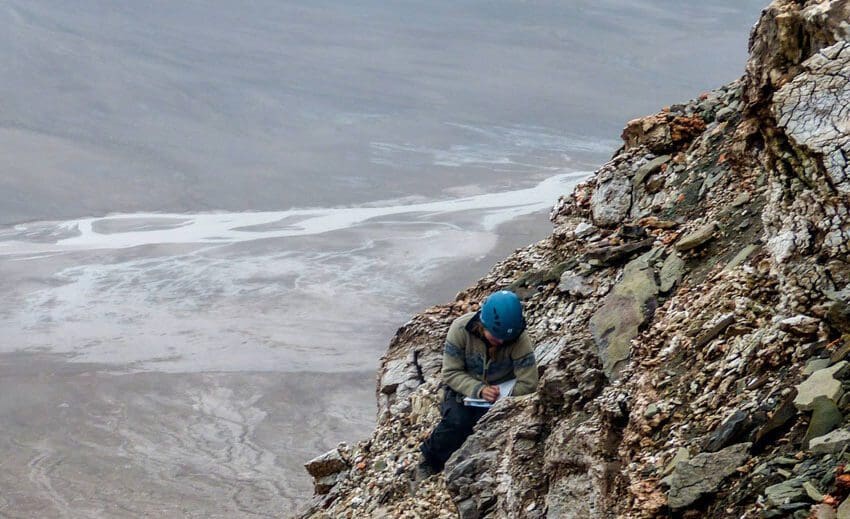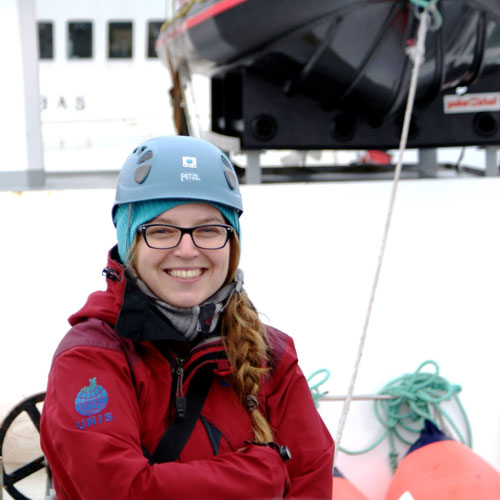New knowledge about sedimentary basins in Svalbard

PhD candidate Aleksandra Smyrak-Sikora on fieldwork in Ebbadalen, Billefjorden, Svalbard. Photo: Tyler Steward/UNIS.
Aleksandra Smyrak-Sikora studied sedimentary basins from the Carboniferous and Triassic periods in Svalbard. She will defend her PhD thesis on 27 February at UNIS.
24 February 2020
Press release from the University Centre in Svalbard (UNIS) and University of Bergen
Sedimentary basins are locations where enough subsidence exists to trap and preserve sediment over geological time. This thesis investigates the evolution of such basins where the subsidence is caused by faulting. Aleksandra’s focus is on two sedimentary successions in Svalbard: Carboniferous age rocks from inner Billefjorden and on the Triassic deposits from west coast of Edgeøya. She performed several seasons of geological mapping combined with three-dimensional digital models of the mountainsides.
The sedimentary rocks in Billefjorden formed when Svalbard was located just 20 degrees north of the equator. The earliest rocks here were deposited in river plains and swamps as sand, clay and peat that reflect a humid warm climate at the time. Through geological time the climate changed to becoming hotter and dryer and it was, coincidentally, during this time that the Earth’s crust became thinner and began to develop faults in Billefjorden which we can still observe and study today. The faults caused subsidence and controlled where sedimentary rocks were deposited and the overall development of the sedimentary basin. When the faulting slowed down the basin was covered over by reefs and lagoons where limestone and rocks formed by the evaporation of seawater were deposited. Even though the sedimentary basin had been covered by this time, the faults still had a big control on how thick and where they were deposited.
On the west coast of Edgeøya Aleksandra worked on rocks that were part of the biggest delta ever recorded in Earth’s history which stretched from the Ural Mountains all the way to Svalbard. In Edgeøya the deposition of these rocks are also controlled by faults. However, in contrast to Billefjorden, the movements along the faults on Edgeøya are not caused by the Earth’s crust thinning, but due to gravity and the complex mechanics of the mudstone rocks below. The difference in thickness of these shales caused instability in the sediment and caused the faults which in turn controlled where the tidal delta sediment was deposited.
Despite the large difference in scale and driving forces, the deposits described on Edgeøya show similar developments in shape and geometry as those studied in Billefjorden. One of Aleksandra’s main findings is that the asymmetric shape we often see in sedimentary basins bounded by faults can initially actually be symmetrical.
The study has major practical implications for the exploration of groundwater aquifers, hydrocarbons, or for underground CO2 storage.
Dissertation
Aleksandra Smyrak-Sikora will defend her PhD thesis, “Development of extensional growth basins: A field based study, Svalbard, Norway”, at 09:15 on 27 February 2020. She will also hold a trial lecture on 26 February at 15:15 entitled “The interplay between tectonics and sedimentation during the evolution of foreland basins”. Both lectures take place in the auditorium Lassegrotta at UNIS.
The committee consists of Professor Haakon Fossen, Department of Earth Science, University of Bergen (committee leader); Professor Mary Ford, Research Center Pétrographiques Et Géochimiques, Nancy, France (1st opponent) and senior researcher Louise Hansen, Geological Survey of Norway (NGU), Trondheim, Norway (2nd opponent). Professor Eva Falck, Department of Earth Science, University of Bergen and UNIS, will lead the dissertation.
The thesis work has been supervised by Snorre Olaussen (UNIS); Alvar Braathen (University of Oslo/UNIS); William Helland-Hansen (University of Bergen/UNIS); and Jan Inge Faleide (University of Oslo).

About the candidate:
Aleksandra Smyrak-Sikora was born in Poland in 1984 and holds a Bachelor’s and Master’s degree from the University of Wroclaw, Poland.
In 2009 /2010 she overwintered at the Polish Polar Station in Hornsund where she worked as a seismologist.
From 2012 she has been a PhD candidate at the Department of Arctic Geology at the University Centre in Svalbard (UNIS). She lives in Longyearbyen with her husband and two daughters.